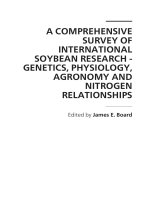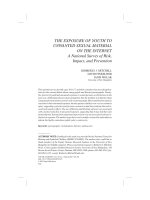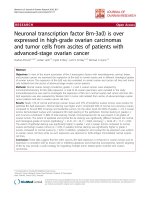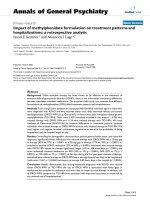A multicenter survey of first-line treatment patterns and gene aberration test status of patients with unresectable Stage IIIB/IV nonsquamous non-small cell lung cancer in China (CTONG 1506)
Bạn đang xem bản rút gọn của tài liệu. Xem và tải ngay bản đầy đủ của tài liệu tại đây (501.42 KB, 7 trang )
Zhou et al. BMC Cancer (2017) 17:462
DOI 10.1186/s12885-017-3451-x
RESEARCH ARTICLE
Open Access
A multicenter survey of first-line treatment
patterns and gene aberration test status of
patients with unresectable Stage IIIB/IV
nonsquamous non-small cell lung cancer in
China (CTONG 1506)
Qing Zhou1, Yong Song2, Xin Zhang3, Gong-Yan Chen4, Dian-Sheng Zhong5, Zhuang Yu6, Ping Yu7,
Yi-Ping Zhang8, Jian-Hua Chen9, Yi Hu10, Guo-Sheng Feng11, Xia Song12, Qiang Shi13, Lu Lu Yang13,
Ping Hai Zhang13 and Yi-Long Wu1*
Abstract
Background: In recent years, systemic chemotherapy and molecular targeted therapy have become standard firstline treatments for locally advanced or metastatic nonsquamous non-small cell lung cancer (NSCLC). The objective
of this survey was to investigate first-line anticancer treatment patterns and gene aberration test status of patients
with advanced nonsquamous NSCLC in China.
Methods: Patients included in this study had unresectable Stage IIIB/IV nonsquamous NSCLC and were admitted
during August 2015 to March 2016 into one of 12 tertiary hospitals throughout China for first-line anticancer treatment.
Patient data (demographics, NSCLC histologic type, Eastern Cooperative Oncology Group [ECOG] Performance Status
[PS], gene aberration test and results [if performed], and first-line anticancer treatment regimen) were extracted from
medical charts and entered into Medical Record Abstraction Forms (MERAFs), which were collated for analysis.
Results: Overall, 1041 MERAFs were collected and data from 932 MERAFs were included for analysis. Patients with
unresectable Stage IIIB/IV nonsquamous NSCLC had a median age of 59 years, 56.4% were male, 58.2% were
never smokers, 95.0% had adenocarcinoma, and 92.9% had an ECOG PS ≤1. A total of 665 (71.4%) patients had
gene aberration tests; 46.5% (309/665) had epidermal growth factor receptor (EGFR) gene mutations, 11.5% (48/416)
had anaplastic lymphoma kinase (ALK) gene fusions, and 0.8% (1/128) had a c-ros oncogene 1 gene fusion. The most
common first-line treatment regimen for unresectable Stage IIIB/IV nonsquamous NSCLC was chemotherapy (72.5%,
676/932), followed by tyrosine kinase inhibitors (TKIs; 26.1%, 243/932), and TKIs plus chemotherapy (1.4%, 13/932). Most
chemotherapy regimens were platinum-doublet regimens (93.5%, 631/676) and pemetrexed was the most common
nonplatinum chemotherapy-backbone agent (70.2%, 443/631) in platinum-doublet regimens. Most EGFR mutationpositive patients (66.3%, 205/309) were treated with EGFR-TKIs.
(Continued on next page)
* Correspondence:
1
Guangdong Lung Cancer Institute, Guangdong General Hospital &
Guangdong Academy of Medical Sciences, 106 Zhongshan 2nd Road,
Guangzhou 510080, Guangdong, China
Full list of author information is available at the end of the article
© The Author(s). 2017 Open Access This article is distributed under the terms of the Creative Commons Attribution 4.0
International License ( which permits unrestricted use, distribution, and
reproduction in any medium, provided you give appropriate credit to the original author(s) and the source, provide a link to
the Creative Commons license, and indicate if changes were made. The Creative Commons Public Domain Dedication waiver
( applies to the data made available in this article, unless otherwise stated.
Zhou et al. BMC Cancer (2017) 17:462
Page 2 of 7
(Continued from previous page)
Conclusions: Findings from our survey of 12 tertiary hospitals throughout China showed an increased rate of gene
aberration testing, compared with those rates reported in previous surveys, for patients with advanced nonsquamous
NSCLC. In addition, pemetrexed/platinum-doublet chemotherapy was the predominant first-line chemotherapy regimen
for this population. Most patients were treated based on their gene aberration test status and results.
Keywords: Chemotherapy, China, Epidermal growth factor receptor, First-line anticancer treatment, Non-small cell lung
cancer, Tyrosine kinase inhibitor
Background
Lung cancer is a major public health concern in China,
accounting for 21.3% of all new cancer cases and 27.1%
of all deaths caused by cancer in 2012 [1]. Approximately 85% of patients presenting with lung cancer have
non-small cell lung cancer (NSCLC) [2], with about 70%
of these patients diagnosed with locally advanced or
metastatic disease [3]. Recommended first-line treatments for these patients are platinum-doublet chemotherapy or molecular targeted therapy, if sensitive gene
aberrations are detected [3–6]. Platinum-doublet chemotherapy has been shown to prolong survival and improve
quality of life in patients with advanced NSCLC [4], with
comparable efficacy among the various regimens [7]. In
NSCLC patients with gene aberrations, molecular targeted therapies have been shown to have greater efficacy
and lower toxicity than standard chemotherapy, whereas
they have limited efficacy in NSCLC patients without
gene aberrations [8].
Findings from a 2010 survey of physicians [9] and a
retrospective review of hospital outpatient databases from
2004 to 2013 [10] in China indicated that NSCLC patients
were mostly treated with platinum-doublet chemotherapy
in the first-line setting. In patients with advanced NSCLC,
the most commonly used chemotherapy regimen was
gemcitabine/carboplatin-doublet chemotherapy [9, 10]. Of
those patients treated with first-line epidermal growth factor receptor (EGFR) tyrosine kinase inhibitors (TKIs),
nearly 50% had an unknown or negative EGFR mutation
status [10]. Reported rates of EGFR gene mutation testing
in China suggest that only 30% of NSCLC patients with
adenocarcinoma are tested for gene aberrations [11] despite more than 40% having EGFR mutations [12, 13].
To determine if these practices have changed in recent
times, we investigated first-line anticancer treatment patterns and gene aberration test status of patients with
unresectable Stage IIIB/IV nonsquamous NSCLC treated
at one of 12 tertiary hospitals throughout China.
Methods
Study design
This was a survey of medical charts from 12 tertiary
hospitals located throughout China (Additional file 1:
Table S1). Data were extracted from medical charts of
patients discharged from hospital between 1 August
2015 and 15 March 2016.
The protocol was approved by the Research Ethics
Committee of the Guangdong General Hospital,
Guangzhou, Guangdong, China. Each site obtained its
own institutional review board or ethics committee approval before the start of the study. The study was conducted in accordance with the ethical principles of the
Declaration of Helsinki and Good Clinical Practice, and
was supported by the Chinese Thoracic Oncology Group
(CTONG study number 1506).
Study population
The medical charts of patients meeting the following
criteria were included for review: aged ≥18 years; diagnosis of unresectable Stage IIIB or IV (according to the
American Joint Committee on Cancer staging system,
7th edition), nonsquamous NSCLC; no previous systemic anticancer treatment for Stage IIIB or IV disease;
and most recent hospitalization was for anticancer
treatment.
Study protocol
Data from all patients’ medical charts who met the inclusion criteria were extracted and entered into the
Medical Record Abstraction Form (MERAF) by designated hospital staff after patient discharge. Data extracted were demographics, NSCLC histological type,
Eastern Cooperative Oncology Group (ECOG) Performance Status (PS), gene aberration test status and results
(if performed), and first-line anticancer treatment regimen. Data entry was reviewed on-site by an independent
data management organization (Shanghai Centennial
Scientific Ltd., Shanghai, China), who assessed accuracy
of data entry by checking 20% of all MERAFs collected
at one hospital selected at random. Completed MERAFs
were collected for analysis.
Data from all collected MERAFs were entered into a
database for analysis, with data entered and verified twice
to ensure accurate data entry. MERAFs were excluded
from analysis if data were missing for gene aberration test
status or first-line anticancer treatment regimen and if
more than 10% of other data were missing.
Zhou et al. BMC Cancer (2017) 17:462
Statistical analysis
Given that there are no published data in China to describe the proportion of patients receiving different types
of chemotherapy, we assumed the proportion of patients
receiving first-line TKI treatment was stable and could
be estimated using the EGFR gene mutation rate. The
sample size calculation assumed an EGFR gene mutation
rate of 30% for East Asian populations [11], data from
897 patients to provide 2-sided 95% confidence intervals
(CIs) with a precision of 3%, and exclusion of 5 to 10%
of MERAFs because of missing data or other errors.
Thus, collection of data from 1000 patients was planned.
Data were summarized with descriptive statistics using
frequency and percentages for categorical data, and median, minimum, and maximum for continuous data.
Analyses were done using SAS® Version 9.3 (SAS Institute, Cary, NC, USA).
Page 3 of 7
Table 1 Demographics and clinical characteristics of patients
with unresectable Stage IIIB/IV nonsquamous non-small cell
lung cancer
Characteristic, n (%)
All patients
N = 932
Age, years
Median (min., max.)
59 (23, 80)
< 65
689 (73.9)
≥ 65
243 (26.1)
Sex
Male
526 (56.4)
Female
406 (43.6)
Residence area
Rural
420 (45.1)
Urban
512 (54.9)
Smoking status
Results
Current Smoker
157 (16.8)
Patient disposition, demographics, and clinical
characteristics
Former Smoker
233 (25.0)
Never Smoker
542 (58.2)
A total of 1041 MERAFs were collected. Of these, 109
MERAFs were excluded because they were of patients
who were discharged from hospital before 1 August
2015 (study start date, n = 74), had missing data
(n = 13), or were duplicates (n = 22). Thus, 932 MERAFs
were included for analysis.
Overall, 73.9% of patients were less than 65 years of
age, 56.4% were male, 58.2% had never smoked, 95.0%
had adenocarcinoma, and 92.9% had an ECOG PS of 0
or 1 (Table 1).
Gene aberration test status and results
Overall, 665 (71.4%) patients had gene aberration tests.
Gene aberration test rates were 71.4% (665/932) for
EGFR gene mutations, 44.7% (416/932) for anaplastic
lymphoma kinase (ALK) gene fusions, and 13.7% (128/
932) for c-ros oncogene 1 (ROS1) gene fusions. Demographics and clinical characteristics of patients who did
and did not have an EGFR gene mutation test were similar (Additional file 2: Table S2).
Gene aberration rates were 46.5% (309/665) for EGFR
gene mutations, 11.5% (48/416) for ALK gene fusions,
0.8% (1/128) for ROS1 gene fusions (Fig. 1). Three patients had a co-existing EGFR gene mutation and an
ALK gene fusion. EGFR gene mutation rates according
to histological subtype were 47.6% (305/641) for adenocarcinoma, 22.2% (2/9) for large cell carcinoma, and
13.3% (2/15) for other histological types. Compared with
the overall study population, a numerically higher proportion of EGFR mutation-positive patients were female
(43.6%, 406/932 vs 56.6%, 175/309, respectively) and had
never smoked (58.2%, 542/932 vs 70.2%, 217/309, respectively) (Table 1 and Additional file 2: Table S2).
Histologic subtype
Adenocarcinoma
885 (95.0)
Large Cell Carcinoma
14 (1.5)
Other
33 (3.5)
ECOG PS
0
291 (31.2)
1
575 (61.7)
2
55 (5.9)
3
11 (1.2)
ECOG Eastern Cooperative Oncology Group, max. maximum, min. minimum, PS
Performance Status
Fig. 1 Gene aberration rates of patients with unresectable Stage IIIB/IV
nonsquamous non-small cell lung cancer. Patients tested for gene
aberrations were classified as positive (activating mutations in exons
18-21), wild type, or unknown (findings inconclusive) for epidermal
growth factor receptor (EGFR) gene mutations, and positive or negative
for anaplastic lymphoma kinase (ALK) and c-ros oncogene 1 (ROS1)
gene fusions
Zhou et al. BMC Cancer (2017) 17:462
First-line anticancer treatment regimens
The predominant first-line anticancer treatment regimen
for patients with unresectable Stage IIIB/IV nonsquamous NSCLC was chemotherapy (72.5%, 676/932)
followed by TKIs (26.1%, 243/932) and TKIs plus
chemotherapy (1.4%, 13/932).
Chemotherapy
Most chemotherapy regimens were platinum-doublet
regimens (93.3%, 631/676). Platinum-doublet chemotherapy regimens consisted primarily of cisplatin (65.0%)
as the platinum agent and pemetrexed (70.2%) as the
nonplatinum chemotherapy-backbone agent (Fig. 2).
Other chemotherapy regimens were triplet regimens
(platinum-doublet chemotherapy plus bevacizumab;
3.7%, 25/676) and singlet regimens (3.0%, 20/676). Triplet regimens consisted of cisplatin (48.0%, 12/25), carboplatin (32.0%, 8/25), or other platinum agents (20.0%,
Page 4 of 7
5/25) and pemetrexed (60.0%, 15/25), paclitaxel (28.0%,
7/25), gemicitibine (8.0%, 2/25), or docetaxel (4.0%, 1/
25) as nonplatinum chemotherapy-backbone agents. Patients treated with triplet regimens were mostly <65 years
(80.0%) with an ECOG PS ≤1 (100%) (Additional file 3:
Table S3). Singlet regimens consisted of pemetrexed
(40.0%, 8/20), docetaxel (30.0%, 6/20), gemcitabine
(20.0%, 4/20), or other nonplatinum chemotherapy
agents (10.0%, 2/20). Patients treated with singlet regimens were more likely to be ≥65 years (50.0%) and have
an ECOG PS ≥2 (30%) (Additional file 3: Table S3).
Tyrosine kinase inhibitors
In total, 243 patients with unresectable Stage IIIB/IV
nonsquamous NSCLC treated with TKIs. Of these patients, 223 (91.8%) were treated with EGFR-TKIs (gefitinib, erlotinib, icotinib, epitinib, or allitinib), of which
205 (91.9%) were EGFR mutation positive. Fewer patients (7.8%, 19/243) were treated with the ALK-TKIs,
crizotinib or ceritinib, and 1 (0.4%) patient was treated
with the vascular endothelial growth factor receptor
(VEGFR)-TKI, apatinib.
Tyrosine kinase inhibitors plus chemotherapy
There were 13 patients treated with TKIs plus chemotherapy; 9 patients received EGFR-TKIs plus chemotherapy
and 4 patients received ALK-TKIs plus chemotherapy.
First-line treatment according to gene aberration test
status
Most patients with unresectable Stage IIIB/IV nonsquamous NSCLC were treated according to their gene aberration test status (Table 2). A large proportion of
patients with EGFR gene mutations were treated with
EGFR-TKIs (67.0%) and nearly all patients with a negative or unknown gene aberration status were treated
with chemotherapy (96.5%). Patients with ALK gene fusions were treated with either chemotherapy (56.3%) or
ALK-TKIs (35.4%). Three patients with ALK gene fusions treated with EGFR-TKIs had co-existing EGFR
gene mutations.
Fig. 2 Doublet chemotherapy regimens of patients with unresectable
Stage IIIB/IV nonsquamous non-small cell lung cancer, n = 631.
a Platinum agents. b Nonplatinum chemotherapy-backbone agents
Discussion
In this survey, we investigated first-line anticancer treatment patterns and gene aberration test status of patients
with unresectable Stage IIIB/IV nonsquamous NSCLC at
12 tertiary hospitals throughout China. More than two
thirds of patients had gene aberration testing and 46.5%
of those tested had EGFR gene mutations. The predominant first-line treatment regimen for unresectable Stage
IIIB/IV nonsquamous NSCLC was pemetrexed/platinum-doublet chemotherapy. Most patients (66.3%) with
EGFR gene mutations were treated with first-line EGFRTKIs. These findings provide an updated and broad
Zhou et al. BMC Cancer (2017) 17:462
Page 5 of 7
Table 2 First-line anticancer treatment according to gene aberration test status
Treatment, n (%)
Gene aberration
N = 932
Positive
EGFRa
ALKb
ROS1
n = 309
n = 48
n=1
207 (67.0)
20 (41.7)d
c
TKI, n = 243
e
d
1
Negative
Unknown
n = 307
n = 267
6 (2.0)
9 (3.4)
EGFR, n = 223
205 (66.3)
3 (6.25)
0
6 (2.0)
9 (3.4)
ALK,f n = 19
1 (0.3)
17 (35.4)
1
0
0
Chemotherapy,g n = 676
95 (30.7)
27 (56.3)
0
296 (96.4)
258 (96.6)
TKI + Chemotherapy, n = 13
7 (2.3)
1 (2.1)
0
5 (1.6)
0
ALK anaplastic lymphoma kinase, EGFR epidermal growth factor receptor, ROS1 c-ros oncogene 1, TKI tyrosine kinase inhibitor, VEGFR vascular endothelial growth
factor receptor
a
EGFR gene mutation positive test included all activating mutations in exons 18-21
b
ALK tests were determined by fluorescence in situ hybridization, immunohistochemistry, or next-generation sequencing
c
One patient with an EGFR gene mutation was treated with the VEGFR-TKI apatinib
d
Three patients with ALK gene fusions had coexisting EGFR gene mutations and were treated with EGFR-TKIs
e
EGFR-TKIs were gefitinib, erlotinib, icotinib, epitinib, and allitinib
f
ALK-TKIs were crizotinib and ceritinib
g
Chemotherapy included singlet, platinum-doublet, and platinum-doublet plus bevacizumab (triplet) regimens
overview of the treatment of unresectable Stage IIIB/IV
nonsquamous NSCLC in China.
In China, testing for EGFR gene mutations is recommended before treating advanced NSCLC [6] and is considered essential for patients with adenocarcinoma given
the high rate of EGFR gene mutations in East Asian patients [8, 14, 15]. In our survey, 71.4% of patients with
unresectable Stage IIIB/IV nonsquamous NSCLC were
tested for EGFR gene mutations, a rate higher than those
reported previously [9, 11]. A 2010 survey of physicians
at general hospitals, chest hospitals, and comprehensive
cancer centers located in 12 major cities throughout
China found only 9.6% of patients with advanced
NSCLC (squamous and nonsquamous histology) were
tested for EGFR gene mutations [9]. Similarly, a 2011
retrospective online survey of patient records found that
China had the lowest rate of EGFR gene mutation testing of the 6 Asian Pacific countries assessed, with 18.3%
of all NSCLC patients and 30.3% of NSCLC patients
with adenocarcinoma histology tested [11]. The improved EGFR gene mutation test rate in our survey suggests changes in clinical practice since 2010–11, possibly
due to increased coverage of testing technology, improved tissue sample collection, and reduced cost. In
addition, there may have been less reliance on patient
characteristics associated with EGFR positive mutations
that prompt testing because similar proportions of never
smokers versus previous/current smokers (72.5%, 393/
542, vs 69.7%, 272/390, respectively) and females versus
males (73.9%, 300/406, vs 69.4%, 365/526) had an EGFR
gene mutation test.
The EGFR gene mutation rate detected in our study
for all patients (46.5%) and for patients with adenocarcinoma histological subtype (47.6%) were similar to
those reported previously for Chinese patients with
NSCLC of adenocarcinoma histology (40.3–64.5%) [14].
In a subset analysis of Chinese patients participating in
the PIONEER study, a prospective molecular epidemiology study of EGFR gene mutations in Asian patients
newly diagnosed with advanced NSCLC of adenocarcinoma histology, 50.2% (95% CI: 46.6–53.8%) of patients
were EGFR mutation positive [12]. In addition, characteristics of EGFR mutation-positive patients in our survey were consistent with those associated with higher
EGFR gene mutation rates (eg, female, never smoker)
[16]. The rate of ALK gene fusions in our study (11.5%)
was slightly higher than those reported previously for
Chinese patients with adenocarcinomas (5.1–10%) [14].
Most patients tested for ALK gene fusions in our study
were EGFR wild type, which may have influenced the
proportion of patients testing positive for an ALK gene
fusion because the occurrence of coexisting EGFR mutations and ALK gene fusions is rare [17]. The rate of
ROS1 gene fusions (0.8%) was similar to those reported
previously (1–2%) in Chinese patients with NSCLC [14].
Platinum-doublet chemotherapy is recommended for
treatment of unresectable, advanced NSCLC [6]. Pemetrexed/platinum-doublet chemotherapy was the predominant treatment regimen for unresectable Stage IIIB/IV
nonsquamous NSCLC in our survey. In a previous survey of Chinese physicians [9], gemcitabine/platinumdoublet chemotherapy was the predominant regimen for
all advanced NSCLC patients (27.4%) and those with
adenocarcinoma histology (32.0%). Although a greater
proportion of patients with adenocarcinoma were
treated with pemetrexed (16.1% vs non-adenocarcinoma
6%, respectively), the prevalence of gemcitabine was attributed to its favorable benefit/toxicity profile, low cost,
Zhou et al. BMC Cancer (2017) 17:462
Page 6 of 7
reimbursement, and low incidence of alopecia [9]. The
preference for pemetrexed/platinum-doublet chemotherapy in our survey may be result of changes in physician
opinion regarding first-line treatment of unresectable
Stage IIIB/IV nonsquamous NSCLC due to increasing
evidence of improved overall survival, better tolerability,
and fewer toxicities with pemetrexed-doublet regimens
than other doublet regimens [18–21] and approval of
pemetrexed for first-line treatment of nonsquamous
NSCLC in combination with cisplatin by the China Food
and Drug Administration in 2014.
Molecular targeted therapy drugs are recommended as
first-line treatment options for advanced NSCLC if sensitive EGFR gene mutations or ALK gene fusions are
detected [3–6], because of their higher efficacy and
lower toxicity than standard chemotherapy in these
patients [8, 22]. In our survey, a large proportion of
EGFR mutation-positive patients were treated with firstline EGFR-TKIs (66.3%); the remaining EGFR mutationpositive patients were treated with chemotherapy (30.7%),
EGFR-TKIs plus chemotherapy (2.3%), or other TKIs
(0.6%). The reason why more than 30% of EGFR
mutation-positive patients received chemotherapy only as
first-line treatment requires further analysis. Encouragingly, most (91.9%) patients treated with first-line
EGFR-TKIs were EGFR mutation positive, a proportion
higher than that previously reported in a retrospective review of an outpatient oncology database (2004–13) in
China (53.5%) [10].
We acknowledge the following limitations of our survey. Our findings from tertiary hospitals may not reflect
the situation for those patients being treated at primary
or secondary hospitals throughout China. The standard
of lung cancer care in China ranges from practices similar to those in Western countries to basic care because
China’s large population, expansive geography, and variable socioeconomic status of patients may affect access
to diagnostic tests and quality oncology services and
treatment [10, 23, 24]. In addition, patients refusing
treatment and outpatients were excluded from our survey, which may have introduced bias into our findings.
In a retrospective review of an outpatient oncology databases in China [10], 19.1% of patients refused treatment
at diagnosis because of poverty, financial insecurity, or
lack of medical insurance.
reported in previous surveys [9, 11], for patients with
unresectable Stage IIIB/IV nonsquamous NSCLC. In
addition, pemetrexed/platinum-doublet chemotherapy
was the predominant first-line regimen for this population and most patients were treated according to their
gene aberration test status.
Conclusion
Our findings from 12 tertiary hospitals located in different geographic areas throughout China provide the most
up-to-date overview of treatment patterns and gene aberration test status of patients with unresectable Stage
IIIB/IV nonsquamous NSCLC. The rate of gene aberration testing was increased, compared with those rates
Ethics approval and consent to participate
The protocol was approved by the Research Ethics Committee of the
Guangdong General Hospital, Guangzhou, Guangdong, China and the study
was supported by the Chinese Thoracic Oncology Group (CTONG study
number 1506). Each site obtained its own institutional review board or ethics
committee approval before the start of the study.
Additional files
Additional file 1: Table S1. Tertiary hospitals participating in the study.
(DOCX 15 kb)
Additional file 2: Table S2. Demographics and clinical characteristics of
patients with unresectable Stage IIIB/IV nonsquamous non-small cell lung
cancer (NSCLC) according to epithelial growth factor receptor (EGFR) gene
mutation test status and results. (DOCX 18 kb)
Additional file 3: Table S3. Demographics and clinical characteristics of
patients with unresectable Stage IIIB/IV nonsquamous non-small cell lung
cancer (NSCLC) according to chemotherapy regimen. (DOCX 16 kb)
Abbreviations
ALK: Anaplastic lymphoma kinase; CI: Confidence interval; CTONG: Chinese
Thoracic Oncology Group; ECOG: Eastern Cooperative Oncology Group;
EGFR: Epidermal growth factor receptor; max.: Maximum; MERAF: Medical
Record Abstraction Form; min.: Minimum; NSCLC: Non-small cell lung cancer;
PS: Performance Status; ROS1: c-ros oncogene 1; TKI: Tyrosine kinase
inhibitor; VEGFR: Vascular endothelial growth factor receptor
Acknowledgements
The authors would like to thank all study participants.
This study was supported by the Chinese Thoracic Oncology Group (CTONG), a
national collaborative clinical research group of 33 member hospitals.
Data collection and analysis was provided by Shanghai Centennial Scientific
Ltd., and was funded by Lilly Suzhou Pharmaceutical Co., China. Medical
writing assistance was provided by Julie Monk, PhD, CMPP and Mark Snape,
MB BS, CMPP of ProScribe – Envision Pharma Group, and was funded by Lilly
Suzhou Pharmaceutical Co., China. ProScribe’s services complied with
international guidelines for Good Publication Practice (GPP3).
Funding
This study was sponsored by Lilly Suzhou Pharmaceutical Co., China. Lilly
Suzhou Pharmaceutical Co., China was involved in the study design,
interpretation of the data, and preparation of the manuscript.
Availability of data and materials
The datasets during and/or analysed during the current study available from
the corresponding author on reasonable request.
Authors’ contributions
QS, LLY, PHZ, Y-LW, and QZ were involved in the study conception and
design. All authors, except QS, LLY, and PHZ, were involved in the acquisition
of data. QS, LLY, PHZ, and Y-LW were involved in the data analyses. All
authors participated in the interpretation of the study results, and in the
drafting, critical revision, and approval of the final version of the manuscript.
Consent for publication
Not applicable.
Zhou et al. BMC Cancer (2017) 17:462
Competing interests
QS, LLY, and PHZ are employees of Lilly Suzhou Pharmaceutical Co., China.
YLW has received honoraria from F. Hoffmann-La Roche, Eli Lilly, AstraZeneca,
and Pfizer. All other authors declare that they have no competing interests.
Publisher’s Note
Springer Nature remains neutral with regard to jurisdictional claims in
published maps and institutional affiliations.
Author details
1
Guangdong Lung Cancer Institute, Guangdong General Hospital &
Guangdong Academy of Medical Sciences, 106 Zhongshan 2nd Road,
Guangzhou 510080, Guangdong, China. 2Nanjing General Hospital of Nanjing
Military Command, Nanjing, Jiangsu, China. 3Zhongshan Hospital, Shanghai,
China. 4The Tumor Hospital affiliated to Harbin Medical University, Harbin,
Heilongjiang, China. 5General Hospital of Tianjin Medical University, Heping,
Tianjin, China. 6The Affiliated Hospital of Qingdao University, Qingdao,
Shandong, China. 7Sichuan Cancer Hospital, Chengdu, Sichuan, China.
8
Zhejiang Cancer Hospital, Hangzhou, Zhejiang, China. 9Hunan Cancer
Hospital, Changsha, Hunan, China. 10Chinese PLA General Hospital, Beijing,
China. 11The People’s Hospital of Guangxi Zhuang Autonomous Region,
Nanning, Guangxi, China. 12Shanxi Cancer Hospital, Taiyuan, Shanxi, China.
13
Lilly Suzhou Pharmaceutical Co., Ltd, Shanghai, China.
Received: 8 January 2017 Accepted: 26 June 2017
References
1. Ferlay J, Soerjomataram I, Ervik M, Dikshit R, Eser S, Mathers C, et al. GLOBOCAN
2012 v1.0, Cancer incidence and mortality worldwide: IARC CancerBase no. 11.
International Agency for Research on Cancer. 2013. />Pages/fact_sheets_population.aspx. Accessed 5 Apr 2016.
2. Molina JR, Yang P, Cassivi SD, Schild SE, Adjei AA. Non-small cell lung cancer:
epidemiology, risk factors, treatment, and survivorship. Mayo Clin Proc. 2008;
83(5):584–94.
3. Besse B, Adjei A, Baas P, Meldgaard P, Nicolson M, Paz-Ares L, et al. 2nd
ESMO consensus conference on lung cancer: non-small-cell lung cancer
first-line/second and further lines of treatment in advanced disease. Ann
Oncol. 2014;25(8):1475–84.
4. Reck M, Popat S, Reinmuth N, De Ruysscher D, Kerr KM, Peters S. Metastatic
non-small-cell lung cancer (NSCLC): ESMO clinical practice guidelines for
diagnosis, treatment and follow-up. Ann Oncol. 2014;25(Suppl 3):27–39.
5. Socinski MA, Evans T, Gettinger S, Hensing TA, VanDam SL, Ireland B, et al.
Treatment of stage IV non-small cell lung cancer: diagnosis and management
of lung cancer, 3rd ed: American College of Chest Physicians evidence-based
clinical practice guidelines. Chest. 2013;143(Suppl 5):e341S–68S.
6. Zhi X-Y, Yu J-M, Shi Y-K. Chinese guidelines on the diagnosis and treatment
of primary lung cancer (2015 version). Cancer. 2016;121:3165–81.
7. Schiller JH, Harrington D, Belani CP, Langer C, Sandler A, Krook J, et al.
Comparison of four chemotherapy regimens for advanced non-small-cell
lung cancer. N Engl J Med. 2002;346(2):92–8.
8. Ke EE, Zhou Q, Wu YL. Emerging paradigms in targeted treatments for
Asian patients with NSCLC. Expert Opin Pharmacother. 2015;16(8):1167–76.
9. Xue C, Hu Z, Jiang W, Zhao Y, Xu F, Huang Y, et al. National survey of the
medical treatment status for non-small cell lung cancer (NSCLC) in China.
Lung Cancer. 2012;77(2):371–5.
10. Yang LL, Zhang XC, Yang XN, Yang JJ, Wang Z, Chen HJ, et al. Lung cancer
treatment disparities in China: a question in need of an answer. Oncologist.
2014;19(10):1084–90.
11. Yatabe Y, Kerr KM, Utomo A, Rajadurai P, Tran VK, Du X, et al. EGFR mutation
testing practices within the Asia Pacific region: results of a multicenter
diagnostic survey. J Thorac Oncol. 2015;10(3):438–45.
12. Shi Y, Li J, Zhang S, Wang M, Yang S, Li N, et al. Molecular epidemiology of
EGFR mutations in Asian patients with advanced non-small-cell lung cancer
of adenocarcinoma histology - mainland China subset analysis of the
PIONEER study. PLoS One. 2015;10(11):e0143515.
13. Gou L-Y, Wu Y-L. Prevalence of driver mutations in non-small-cell lung cancers
in the People’s Republic of China. Lung Cancer Targets Ther. 2014;5:1–9.
14. Zhou C. Lung cancer molecular epidemiology in China: recent trends. Transl
Lung Cancer Res. 2014;3(5):270–9.
Page 7 of 7
15. Shi Y, Au JS, Thongprasert S, Srinivasan S, Tsai CM, Khoa MT, et al. A prospective,
molecular epidemiology study of EGFR mutations in Asian patients with
advanced non-small-cell lung cancer of adenocarcinoma histology (PIONEER).
J Thorac Oncol. 2014;9(2):154–62.
16. Wang S, Wang Z. EGFR mutations in patients with non-small cell lung cancer
from mainland China and their relationships with clinicopathological features:
a meta-analysis. Int J Clin Exp Med. 2014;7(8):1967–78.
17. Lou NN, Zhang XC, Chen HJ, Zhou Q, Yan LX, Xie Z, et al. Clinical outcomes of
advanced non-small-cell lung cancer patients with EGFR mutation, ALK
rearrangement and EGFR/ALK co-alterations. Oncotarget. 2016;7(40):65185–95.
18. Scagliotti GV, Parikh P, von Pawel J, Biesma B, Vansteenkiste J, Manegold C,
et al. Phase III study comparing cisplatin plus gemcitabine with cisplatin
plus pemetrexed in chemotherapy-naive patients with advanced-stage
non-small-cell lung cancer. J Clin Oncol. 2008;26(21):3543–51.
19. Xiao HQ, Tian RH, Zhang ZH, Du KQ, Ni YM. Efficacy of pemetrexed plus
platinum doublet chemotherapy as first-line treatment for advanced
nonsquamous non-small-cell-lung cancer: a systematic review and metaanalysis. Onco Targets Ther. 2016;9:1471–6.
20. Wu YL, Lu S, Cheng Y, Zhou C, Wang M, Qin S, et al. Efficacy and safety of
pemetrexed/cisplatin versus gemcitabine/cisplatin as first-line treatment in
Chinese patients with advanced nonsquamous non-small cell lung cancer.
Lung Cancer. 2014;85(3):401–7.
21. Li M, Zhang Q, Fu P, Li P, Peng A, Zhang G, et al. Pemetrexed plus platinum
as the first-line treatment option for advanced non-small cell lung cancer: a
meta-analysis of randomized controlled trials. PLoS One. 2012;7(5):e37229.
22. Shi Y, Sun Y, Ding C, Wang Z, Wang C, Wang Z, et al. China experts consensus
on icotinib for non-small cell lung cancer treatment (2015 version). Ann Transl
Med. 2015;3(18):260.
23. Goss PE, Strasser-Weippl K, Lee-Bychkovsky BL, Fan L, Li J, Chavarri-Guerra Y,
et al. Challenges to effective cancer control in China, India, and Russia.
Lancet Oncol. 2014;15(5):489–538.
24. American Cancer Society. Global cancer facts & figures. 3rd ed. Atlanta:
American Cancer Society; 2015.
Submit your next manuscript to BioMed Central
and we will help you at every step:
• We accept pre-submission inquiries
• Our selector tool helps you to find the most relevant journal
• We provide round the clock customer support
• Convenient online submission
• Thorough peer review
• Inclusion in PubMed and all major indexing services
• Maximum visibility for your research
Submit your manuscript at
www.biomedcentral.com/submit









